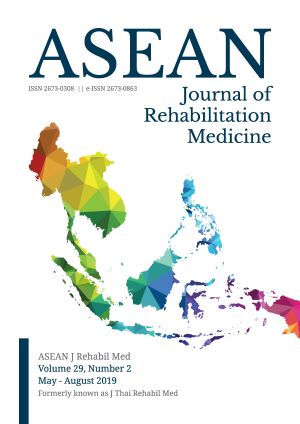A Randomized Trial of the Effect of Self-care Booklet Plus Routine Care Compared with Routine Care Alone in Breast Cancer-related Lymphedema Patients
A Randomized Trial of the Effect of Self-care Booklet Plus Routine Care Compared with Routine Care Alone in Breast Cancer-related Lymphedema Patients
Keywords:
breast cancer related lymphedema, self-care booklet, patient educationAbstract
Abstract
Objectives: To investigate the effectiveness of the self-care booklet plus routine care on reducing arm volume in patients with breast cancer related lymphedema (BCRL).
Setting: Outpatient department, Department of Rehabilitation Medicine, Siriraj Hospital.
Study design: Prospective, randomized single-blinded controlled trial.
Subjects: Fifty-one patients with stage 1 or 2 BCRL were enrolled during December 2017 and December 2018.
Methods: Patients were randomized into 2 groups, the intervention group received self-care booklet plus routine care and the control group receives routine care alone for 12 weeks. Patients in the intervention group were asked to follow the instructions in the booklets and record their self-monitor routine in the booklet weekly. Arm volume, quality of life, arm range of motions, patients’ knowledge, and overall satisfactions were recorded at baseline, 4 weeks and 12 weeks.
Results: After using the self-care booklet for 4 weeks, patients in the intervention group demonstrated significantly higher score in the physical sub-scale of the Lymph-ICF questionnaire when compared between groups (p=0.046) but there were no significant differences regarding the arm volume reduction and knowledge score. After 12 weeks, there were significant increases in shoulder forward flexion and shoulder abduction ROM (p= 0.033, 0.025 respectively) in the intervention group but no difference between groups was found in terms of arm ROM, volume reduction, knowledge score, overall satisfaction and adverse events.
Conclusion: The self-care booklet plus routine care demonstrated some benefit for women with stage 1 or 2 BCRL in terms of improving the physical subscale QOL score after using for 4 weeks. But after 12 weeks, there were no difference from the routine care alone.
References
1. Torre LA, Bray F, Siegel RL, Ferlay J, Lortet-Tieulent J, Jemal A. Global cancer statistics, 2012. CA Cancer J Clin. 2015;65:87-108.
2. Heisig SR, Shedden-Mora MC, von Blanckenburg P, Rief W, Witzel I, Albert US, et al. What do women with breast cancer expect from their treatment? Correlates of negative treatment expectations about endocrine therapy. Psychooncology. 2016;25:1485-92.
3. Hidding JT, Beurskens CH, van der Wees PJ, van Laarhoven HW4, Nijhuis-van der Sanden MW. Treatment related impairments in arm and shoulder in patients with breast cancer: a systematic review. PLoS One. 2014;9.
4. Armer JM, Stewart BR. Post-breast cancer lymphedema: incidence increases from 12 to 30 to 60 months. Lymphology. 2010; 43:118-27.
5. Shih YC, Xu Y, Cormier JN, Giordano S, Ridner SH, Buchholz TA, et al. Incidence, treatment costs, and complications of lymphedema after breast cancer among women of working age: a 2-year follow-up study. J Clin Oncol. 2009;27:2007-14.
6. Chachaj A, Małyszczak K, Pyszel K, Lukas J, Tarkowski R, Pudełko M, et al. Physical and psychological impairments of women with upper limb lymphedema following breast cancer treatment. Psychooncology. 2010;19:299-305.
7. Paskett ED, Naughton MJ, McCoy TP, Case LD, Abbott JM. The epidemiology of arm and hand swelling in premenopausal breast cancer survivors. Cancer Epidemiol Biomarkers Prev. 2007;16: 775-82.
8. Lymphoedema Framework. Best Practice for the Management of Lymphoedema. International consensus. London: MEP; 2006.
9. Gary DE. Lymphedema diagnosis and management. J Am Acad Nurse Pract. 2007;19:72-8.
10. Meneses KD, McNees MP. Upper extremity lymphedema after treatment for breast cancer: a review of the literature. Ostomy Wound Manage. 2007;53:16-29.
11. Fife CE, Davey S, Maus EA, Guilliod R, Mayrovitz HN. A randomized controlled trial comparing two types of pneumatic compression for breast cancer-related lymphedema treatment in the home. Support Care Cancer. 2012;20:3279-86.
12. Radina ME, Armer JM. Post-Breast Cancer Lymphedema and the Family: A Qualitative Investigation of Families Coping With Chronic Illness. J Fam Nurse. 2001;7:281-99.
13. Kisner C, Colby LA. Therapeutic exercise: foundations and techniques. Philadelphia: F. A. Davis Company; 2012.
14. Chassé D. Lymphedema management in women’s health physical therapy. American Physical Therapy Association; 2015.
15. Valerie W. Collins. Lymphedema management self-care workbook. Lymphedema Management Self Care Workbook. UNC Healthcare; 2012.
16. Patient Information Lymphedema. Patient information lymphedema. London: London Health Science Center; 2011.
17. Simple lymphatic drainage of the upper limb. Northumbria Healthcare NHS Foundation Trust; 2017.
18. Sagen A, Kåresen R, Skaane P, Risberg MA. Validity for the simplified water displacement instrument to measure arm lymphedema as a result of breast cancer surgery. Arch Phys Med Rehabil. 2009;90:803-9.
19. Devoogdt N, Van Kampen M, Geraerts I, Coremans T, Christiaens MR.Lymphoedema Functioning, Disability and Health questionnaire (Lymph-ICF): reliability and validity. Phys Ther. 2011;91:944-57.
20. Rosner B. Fundamentals of biostatistics. 7th ed. Boston: Brooks/Cole; 2011.
21. Cormier JN, Xing Y, Zaniletti I, Askew RL, Stewart BR, Armer JM.Minimal limb volume change has a significant impact on breast cancer survivors. Lymphology. 2009;42:161-75.






